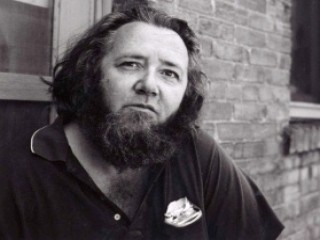
Ted Berrigan biography
Date of birth : 1934-11-15
Date of death : 1983-07-04
Birthplace : Providence, Rhode Island, United States
Nationality : American
Category : Famous Figures
Last modified : 2011-05-26
Credited as : Author, and poet, The Sonnets
0 votes so far
A prominent figure in the second generation of the New York School of Poets, Berrigan was peer to Jim Carroll, Anselm Hollo, Ron Padgett, Anne Waldman, and Lewis Warsh. He collaborated with Padgett and Joe Brainard on Bean Spasms, a work significant in its rejection of traditional concepts of ownership. Though Berrigan, Padgett, and Brainard all wrote individual poems for the book, and collaborated on many others, no authors were listed for individual poems.
In 2005, Ted Berrigan's published and unpublished poetry was published together in a single volume edited by the poet Alice Notley, Berrigan's second wife, and their two sons, Anselm Berrigan – a poet – and Edmund Berrigan, a poet and songwriter.
The Sonnets
The poet Frank O'Hara called Berrigan's most significant publication, The Sonnets, “a fact of modern poetry.” A telling reflection on the era that produced it, The Sonnets beautifully weaves together traditional elements of the Shakespearean sonnet form with the disjunctive structure and cadence of T. S. Eliot’s The Waste Land and Berrigan’s own literary innovations and personal experiences. The product is a composition, in the words of Berrigan’s editor and second wife Alice Notley, “[that is] musical, sexy, and funny.”
Berrigan was initially drawn to the sonnet form because of its inherent challenge; in his own words, "the form sort of [stultifies] the whole process [of writing]." The procedure that he ultimately concocted to write The Sonnets is the essence of the work’s novelty and ingenuity. After attempting several sonnets, Berrigan decided to go back through what he had written and take out certain lines, one line from each work until he had six lines. He then went through the poems backwards and took one more line from each until he had accumulated six more lines, twelve lines total. Based on this body of the work, Berrigan knew what the final couplet would be; this process became the basis for The Sonnets. Addressing claims that the method is totally mechanical, Berrigan explains that some of the seventy-seven sonnets came to him "whole," not needing to be pieced together. The poet’s preoccupation with style, his concern for form and his own role as the creator as evinced by The Sonnets pose a challenge to traditional ideas about poetry and signify a fresh and innovative artistic approach.
The book recognizes the eternal possibility for invention in a genre seemingly overwhelmed by the success of its traditional forms. By imitating the forms and practices of earlier artists and recreating them to express personal ideas and experiences, Berrigan demonstrates the potential for poetry in his and subsequent generations. As Charles Bernstein succinctly comments, "Part collage, part process writing, part sprung lyric, Ted Berrigan’s The Sonnets remains…one of the freshest and most buoyantly inspired works of contemporary poetry. Reinventing verse for its time, The Sonnets are redolent with possibilities for our own."
Author of books:
The Sonnets (1964, poetry)
Bean Spasms (1967, poetry, with Rod Padgett)
Many Happy Returns (1969, poetry)
In the Early Morning Rain (1970, poetry)
Train Ride: For Joe (1971, poetry)
A Feeling for Leaving (1975, poetry)
Red Wagon (1976, poetry)
Nothing for You (1977, poetry)
Clear the Range (1977, poetry)
In a Blue River (1981, poetry)
The Morning Line (1982, poetry)
A Certain Slant of Sunlight (1988, poetry)
















